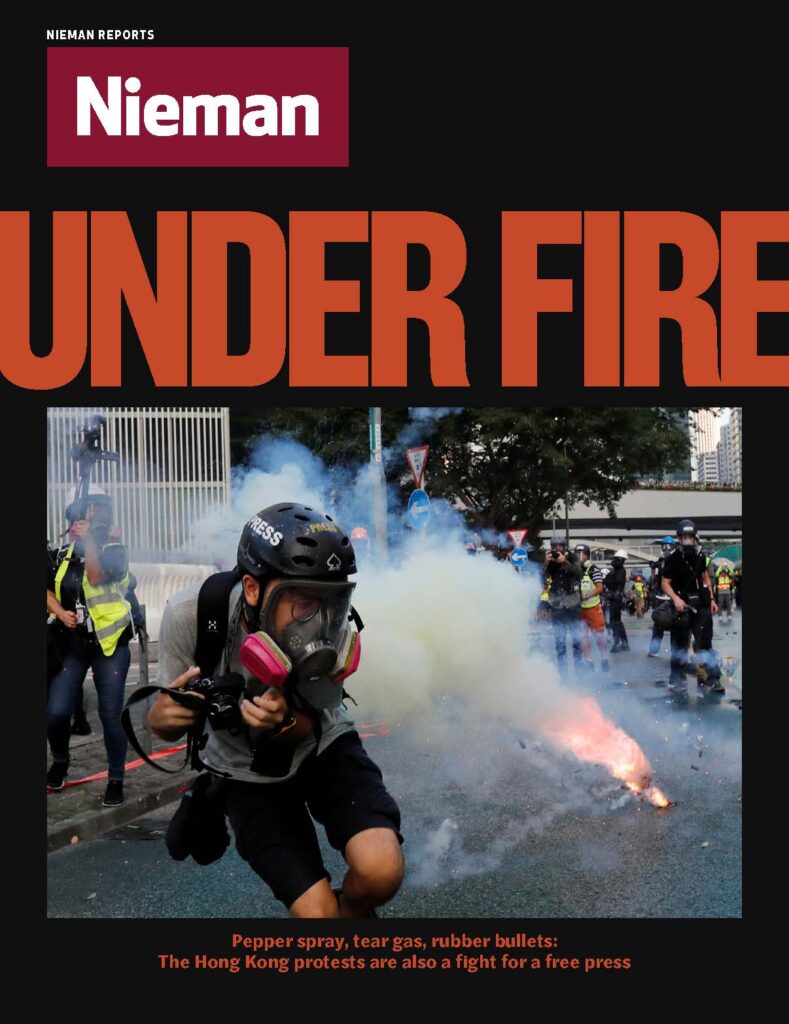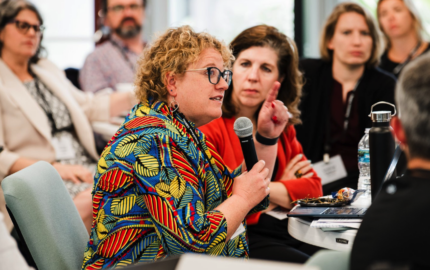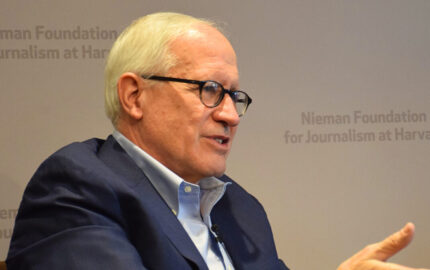In the fall of 2017 The New York Times published Jodi Kantor’s and Megan Twohey’s explosive investigation into the sexual harassment and abuse allegations against film mogul Harvey Weinstein. During their book tour for “She Said: Breaking the Sexual Harassment Story That Helped Ignite a Movement,” they spoke at the Nieman Foundation in conversation with curator Ann Marie Lipinski in early October.
Before the Weinstein investigation, each of the two reporters already had deep experience telling stories that made a difference. At the Chicago Tribune, Twohey did two investigations that led to new laws. She uncovered untested rape kits gathering dust in police storage and she detailed the cases of sex-abusing doctors who were continuing to practice. One doctor went to prison because of her reporting. “There was uniform outrage once you were able to obtain the truth,” she says. “One of the reasons I kept doing investigations was that of all the journalism I had done, it felt so satisfying, especially to the victims.”
Related Reading
“There were huge consequences for anybody who talked to us”
New York Times reporters Emily Steel and Michael S. Schmidt on covering sexual harassment allegations, convincing sources to go on the record, and reverse engineering nondisclosure agreements
The News Industry Has a Sexual Harassment Problem. #NowWhat?
How newsroom leaders can create workplaces that truly support women
By Katherine Goldstein
When Women Stand Up Against Harassers in the Newsroom
We don’t need more training—we know what to do
By Ann Marie Lipinski
Kantor’s work at the Times in recent years has focused on investigative journalism about women in the workplace. Her reporting on the punishing algorithm that was used to schedule workers at Starbucks helped spark a fair scheduling movement that has led to new laws and policies. Gender also was a theme of her reporting on Amazon’s treatment of its white-collar workers. Talking to Amazon workers about breaking their nondisclosure agreements (NDAs) turned out to be good preparation for the Weinstein story.
Secrecy turned out to also be a big part of the Weinstein story. Twohey notes that Weinstein was able to prevent company officials and lawyers from scrutinizing his behavior. “I think this raises questions for the boards of companies everywhere and the executives in power everywhere: What does it look like when you allow the boss to basically act with impunity?”
Edited excerpts:
On the game-changing Bill O’Reilly story
Jodi Kantor: Following President Trump’s election in 2016, I spent a long time worrying about what story I could do that could possibly be equal to the moment. Then what happened is that Emily Steel and Michael Schmidt did the Bill O’Reilly story.
That was the story that changed everything. I know that, in the public imagination, it can seem like, “Oh, yeah, Bill O’Reilly. That was, like, a hundred sexual harassment stories ago.”
Honestly, it was a game‑changer and deserves to be remembered as such, for two reasons. One is that the idea that a man as powerful as O’Reilly at a conservative network could be fired, not for these allegations piling up because Fox had known about that, but fired for public exposure by journalists of these claims, was totally shocking.
Also, what Emily and Mike did was essentially invent a new way of reporting on stuff. So often in journalism, the fact that somebody had settled meant that you couldn’t write about it. They essentially reverse‑engineered the settlements, and they eventually figured out, by the way, that O’Reilly and Fox paid $45 million to women to silence their claims.
All of a sudden, we had a new playbook for how to do these stories. The editors came to me and to several other reporters and said: “What other powerful men in American life should we look into?
On gaining sources’ trust
Kantor: There was a point in the summer of 2017 where Megan and I wrote a joint bio to send to actresses, because we were trying to send the message that we were not entertainment journalists, we were coming from impact‑oriented backgrounds.
Megan Twohey: When you’re making a case to somebody, whether or not they should go on the record, I’ve always said, “We can't change what's happened to you in the past. If you work with us and we publish the truth, we might be able to protect other people. We might finally be able to bring about accountability.”
Kantor: It was really helpful to be able to show people that Bill O’Reilly story and then the story that Katie Benner did about the women in Silicon Valley.
The way we wanted to come off was to say, “We know that surgery is really tricky, but we’re the surgeons who know how to do it, and you're at the hospital that has a good track record of getting the patient out alive.”
On handling Harvey Weinstein and his representatives
Kantor: I think, for this investigation, not allowing Weinstein to speak off the record with us was the right call. I think it put Weinstein on notice that we were very serious. What you can now see in the pages of the book is that this is a world‑class bullshitter and manipulator, who did plenty of lying, even on the record.
When you let someone talk to you off the record, you run the risk of letting them lie to you with impunity, and we couldn’t let that happen.
We, of course, wanted to hear his side of the story, but it needed to be done in a very structured way. We needed to fully understand as many female allegations as possible before sitting down with him.
Twohey: We did choose to engage on background with Lanny Davis, who was hired by Weinstein as sort of a crisis PR person. I thought it would be valuable to know what they had. In my experience, if you engage with people who have something to hide, they’ll often hang themselves by accident. What we were able to do in that first on-background interview was start to flip the tables and get him to start to open up about secret settlements that had been paid. Lanny Davis ultimately ended up giving us information that went into the story and that was useful.
On naming or not naming victims
Kantor: What’s greatly complicated all of this is the internet because it used to be that when you published a local paper and it was in print, a limited number of people would see it. With everybody we name in the paper, that name is everywhere on the internet instantaneously. Social media is part of what gave these stories this force, but I think social media also makes it scarier to go on the record.
On journalism vs. activism
Twohey: Jodi and I have always been very firm about the fact that there is a distinction between what we do and what activists do. It’s summed up by the saying, “If your mother tells you she loves you, check it out."
That is the process that we follow. We listen to these allegations, and we take them very seriously, but then we set about applying a very rigorous process by which we seek to verify.
We’re not out there in the streets. You’re not going to see us at the Women’s March. You're not going to see us lobbying Congress for new laws.
When we’re reporting the story on Weinstein, even if it means going through a process in which he's barging into the newsroom with all of his high‑priced lawyers and threatening to sue us, we're going to go through that process, because we think, at the end of the day, we're going to come out with a story, with findings, with a publishable work that's going to stand up.
There’s not going to be a debate about what’s happened. The debate’s going to be what’s going to happen in response.
On the limits of #MeToo journalism
Kantor: This is a case in which journalism stepped in when other systems failed. Megan and I have been staggered by the power that the journalism ended up having, but we feel really strongly that this is also a story about the limits of journalism.
What happened in the wake of #MeToo is that the paper and every other publication were flooded with these tips. It’s still happening to this day. Our email inboxes, our phones, our Instagram accounts are over‑piled with stories of women who had a problem and essentially want something done about it.
”Journalism is not a volume business, and it’s not a substitute, ultimately, for institutions that have failed. I am left hopeful by the impact we had. We’re committed to continuing to do this work, but it’s not a fundamental, structural solution, by any means.




